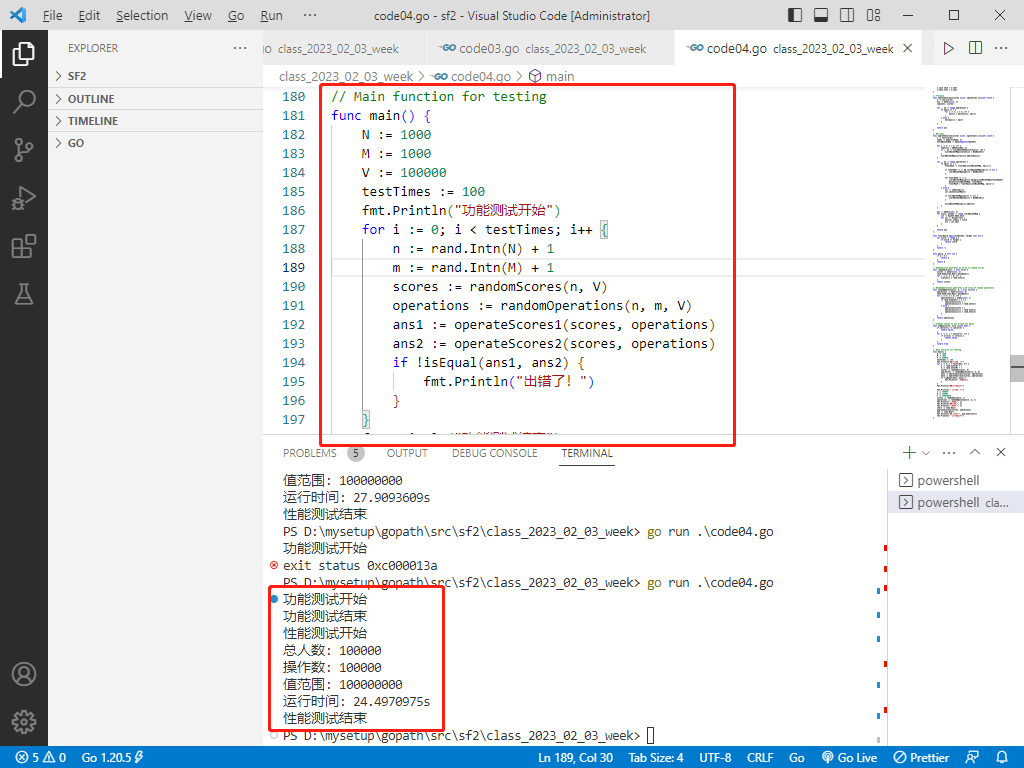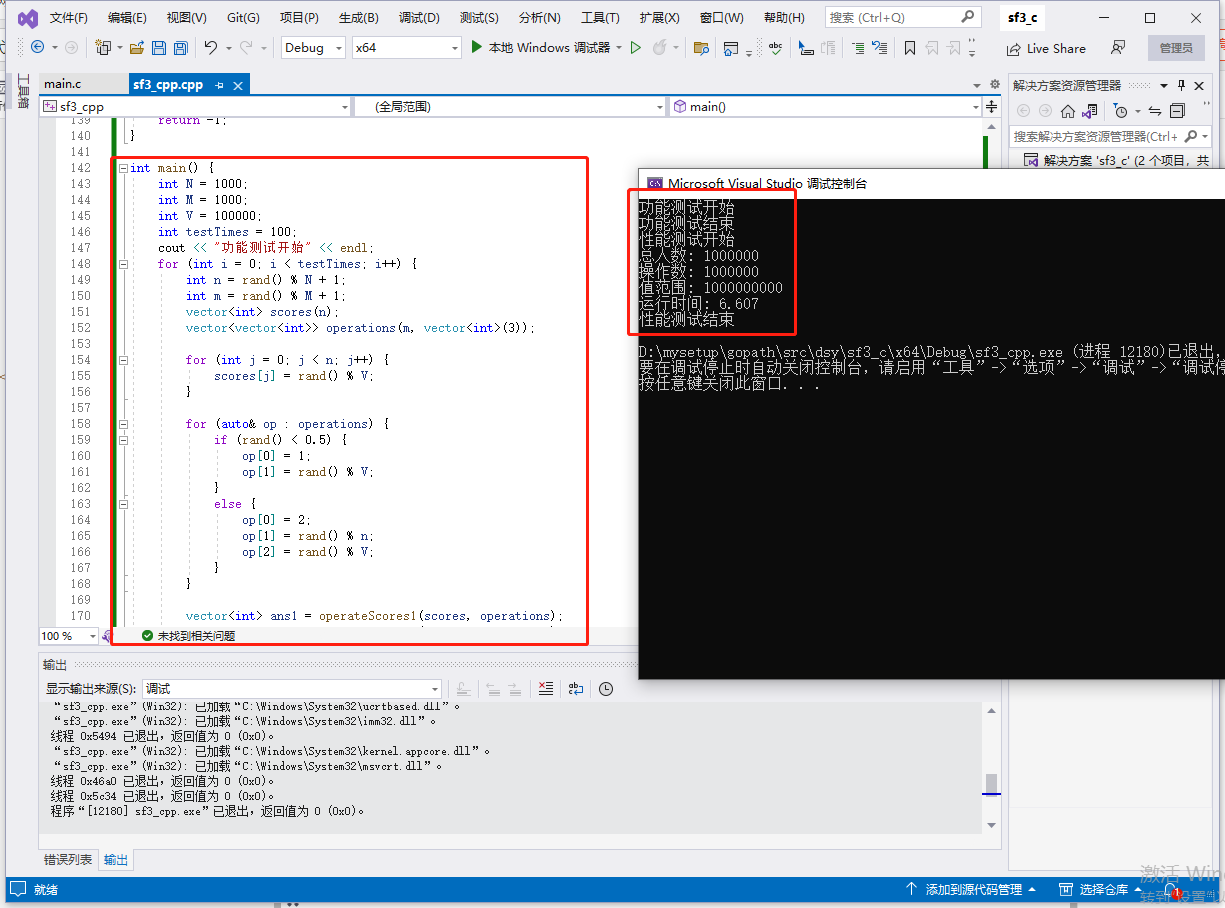2023-06-18:给定一个长度为N的一维数组scores, 代表0~N-1号员工的初始得分, scores[i] = a, 表示i号员工一开始得分是a, 给定一个长度为M的二维数组operatio
2023-06-18:给定一个长度为N的一维数组scores, 代表0~N-1号员工的初始得分,
scores[i] = a, 表示i号员工一开始得分是a,
给定一个长度为M的二维数组operations,
operations[i] = {a, b, c}。
表示第i号操作为 :
如果a==1, 表示将目前分数<b的所有员工,分数改成b,c这个值无用,
如果a==2, 表示将编号为b的员工,分数改成c,
所有操作从0~M-1, 依次发生。
返回一个长度为N的一维数组ans,表示所有操作做完之后,每个员工的得分是多少。
1 <= N <= 10的6次方,
1 <= M <= 10的6次方,
0 <= 分数 <= 10的9次方。
来自TikTok美国笔试。
答案2023-06-18:
具体步骤如下:
1.创建一个长度为N的一维数组scores,表示每个员工的初始得分。
2.创建一个长度为M的二维数组operations,表示操作序列。
3.定义一个函数operateScores2来处理操作序列。
4.初始化一个节点数组nodes,用于存储每个员工的节点信息。
5.初始化一个空的得分和桶的映射表scoreBucketMap。
6.遍历scores数组,为每个得分值创建一个桶,并将对应的员工节点添加到桶中。
7.遍历operations数组,处理每个操作。
8.对于类型为1的操作,获取小于当前得分的最大得分值floorKeyV,然后将它们的桶合并到新的得分值对应的桶中。
9.对于类型为2的操作,获取该员工节点,并将其从原来的桶中移除,然后添加到新的得分值对应的桶中。
10.遍历得分和桶的映射表scoreBucketMap,将桶中的员工节点按照顺序取出,更新到结果数组ans中。
11.返回最终的结果数组ans。
12.进行功能测试和性能测试。
时间复杂度分析:
遍历
scores数组并创建桶,时间复杂度为O(N)。遍历
operations数组,每个操作的时间复杂度为O(logN)(由于使用了有序映射表来实现桶,检索操作的时间复杂度为O(logN))。遍历得分和桶的映射表
scoreBucketMap,每个桶中的员工节点数量为O(1),遍历的时间复杂度为O(N)。总体时间复杂度为O(N + KlogN),其中K为操作序列的长度。
空间复杂度分析:
创建一个长度为N的数组
scores,空间复杂度为O(N)。创建一个长度为M的数组
operations,空间复杂度为O(M)。创建一个长度为N的节点数组
nodes,空间复杂度为O(N)。创建一个有序映射表
scoreBucketMap,储存每个得分值对应的桶,空间复杂度为O(N)。结果数组
ans的长度为N,空间复杂度为O(N)。总体空间复杂度为O(N + M)。
go完整代码如下:
package main
import (
"fmt"
"math/rand"
"time"
)
// 桶,得分在有序表里!桶只作为有序表里的value,不作为key
type Bucket struct {
head *Node
tail *Node
}
func NewBucket() *Bucket {
head := &Node{index: -1}
tail := &Node{index: -1}
head.next = tail
tail.last = head
return &Bucket{head: head, tail: tail}
}
func (b *Bucket) add(node *Node) {
node.last = b.tail.last
node.next = b.tail
b.tail.last.next = node
b.tail.last = node
}
func (b *Bucket) merge(join *Bucket) {
if join.head.next != join.tail {
b.tail.last.next = join.head.next
join.head.next.last = b.tail.last
join.tail.last.next = b.tail
b.tail.last = join.tail.last
join.head.next = join.tail
join.tail.last = join.head
}
}
// Node represents a node in the bucket
type Node struct {
index int
last *Node
next *Node
}
func (n *Node) connectLastNext() {
n.last.next = n.next
n.next.last = n.last
}
// 暴力方法
func operateScores1(scores []int, operations [][]int) []int {
n := len(scores)
ans := make([]int, n)
copy(ans, scores)
for _, op := range operations {
if op[0] == 1 {
for i := 0; i < n; i++ {
ans[i] = max(ans[i], op[1])
}
} else {
ans[op[1]] = op[2]
}
}
return ans
}
// 正式方法
func operateScores2(scores []int, operations [][]int) []int {
n := len(scores)
nodes := make([]*Node, n)
scoreBucketMap := make(map[int]*Bucket)
for i := 0; i < n; i++ {
nodes[i] = &Node{index: i}
if _, ok := scoreBucketMap[scores[i]]; !ok {
scoreBucketMap[scores[i]] = NewBucket()
}
scoreBucketMap[scores[i]].add(nodes[i])
}
for _, op := range operations {
if op[0] == 1 {
floorKeyV := floorKey(scoreBucketMap, op[1]-1)
if floorKeyV != -1 && scoreBucketMap[op[1]] == nil {
scoreBucketMap[op[1]] = NewBucket()
}
for floorKeyV != -1 {
scoreBucketMap[op[1]].merge(scoreBucketMap[floorKeyV])
delete(scoreBucketMap, floorKeyV)
floorKeyV = floorKey(scoreBucketMap, op[1]-1)
}
} else {
cur := nodes[op[1]]
cur.connectLastNext()
if scoreBucketMap[op[2]] == nil {
scoreBucketMap[op[2]] = NewBucket()
}
scoreBucketMap[op[2]].add(cur)
}
}
ans := make([]int, n)
for score, bucket := range scoreBucketMap {
cur := bucket.head.next
for cur != bucket.tail {
ans[cur.index] = score
cur = cur.next
}
}
return ans
}
func floorKey(m map[int]*Bucket, target int) int {
for score := range m {
if score <= target {
return score
}
}
return -1
}
func max(a, b int) int {
if a > b {
return a
}
return b
}
// RandomScores generates an array of random scores
func randomScores(n, v int) []int {
scores := make([]int, n)
rand.Seed(time.Now().UnixNano())
for i := 0; i < n; i++ {
scores[i] = rand.Intn(v)
}
return scores
}
// RandomOperations generates a 2D array of random operations
func randomOperations(n, m, v int) [][]int {
operations := make([][]int, m)
rand.Seed(time.Now().UnixNano())
for i := 0; i < m; i++ {
operations[i] = make([]int, 3)
if rand.Float32() < 0.5 {
operations[i][0] = 1
operations[i][1] = rand.Intn(v)
} else {
operations[i][0] = 2
operations[i][1] = rand.Intn(n)
operations[i][2] = rand.Intn(v)
}
}
return operations
}
// IsEqual checks if two arrays are equal
func isEqual(arr1, arr2 []int) bool {
if len(arr1) != len(arr2) {
return false
}
for i := 0; i < len(arr1); i++ {
if arr1[i] != arr2[i] {
return false
}
}
return true
}
// Main function for testing
func main() {
N := 1000
M := 1000
V := 100000
testTimes := 100
fmt.Println("功能测试开始")
for i := 0; i < testTimes; i++ {
n := rand.Intn(N) + 1
m := rand.Intn(M) + 1
scores := randomScores(n, V)
operations := randomOperations(n, m, V)
ans1 := operateScores1(scores, operations)
ans2 := operateScores2(scores, operations)
if !isEqual(ans1, ans2) {
fmt.Println("出错了!")
}
}
fmt.Println("功能测试结束")
fmt.Println("性能测试开始")
n := 100000
m := 100000
v := 100000000
scores := randomScores(n, v)
operations := randomOperations(n, m, v)
fmt.Println("总人数:", n)
fmt.Println("操作数:", n)
fmt.Println("值范围:", v)
start := time.Now()
operateScores2(scores, operations)
end := time.Now()
fmt.Println("运行时间:", end.Sub(start))
fmt.Println("性能测试结束")
}

c++完整代码如下:
#include <iostream>
#include <vector>
#include <map>
#include <random>
#include <ctime>
using namespace std;
class Bucket;
// Node represents a node in the bucket
class Node {
public:
int index;
Node* last;
Node* next;
void connectLastNext() {
last->next = next;
next->last = last;
}
};
// Bucket, scores stored in a sorted list
class Bucket {
public:
Node* head;
Node* tail;
Bucket() {
head = new Node();
tail = new Node();
head->index = -1;
tail->index = -1;
head->next = tail;
tail->last = head;
}
void add(Node* node) {
node->last = tail->last;
node->next = tail;
tail->last->next = node;
tail->last = node;
}
void merge(Bucket* join) {
if (join->head->next != join->tail) {
tail->last->next = join->head->next;
join->head->next->last = tail->last;
join->tail->last->next = tail;
tail->last = join->tail->last;
join->head->next = join->tail;
join->tail->last = join->head;
}
}
};
vector<int> operateScores1(const vector<int>& scores, const vector<vector<int>>& operations) {
int n = scores.size();
vector<int> ans(scores);
for (const auto& op : operations) {
if (op[0] == 1) {
for (int i = 0; i < n; i++) {
ans[i] = max(ans[i], op[1]);
}
}
else {
ans[op[1]] = op[2];
}
}
return ans;
}
int floorKey(const map<int, Bucket*>& m, int target);
vector<int> operateScores2(const vector<int>& scores, const vector<vector<int>>& operations) {
int n = scores.size();
vector<Node*> nodes(n);
map<int, Bucket*> scoreBucketMap;
for (int i = 0; i < n; i++) {
nodes[i] = new Node();
nodes[i]->index = i;
if (scoreBucketMap.find(scores[i]) == scoreBucketMap.end()) {
scoreBucketMap[scores[i]] = new Bucket();
}
scoreBucketMap[scores[i]]->add(nodes[i]);
}
for (const auto& op : operations) {
if (op[0] == 1) {
int floorKeyV = floorKey(scoreBucketMap, op[1] - 1);
if (floorKeyV != -1 && scoreBucketMap.find(op[1]) == scoreBucketMap.end()) {
scoreBucketMap[op[1]] = new Bucket();
}
while (floorKeyV != -1) {
scoreBucketMap[op[1]]->merge(scoreBucketMap[floorKeyV]);
scoreBucketMap.erase(floorKeyV);
floorKeyV = floorKey(scoreBucketMap, op[1] - 1);
}
}
else {
Node* cur = nodes[op[1]];
cur->connectLastNext();
if (scoreBucketMap.find(op[2]) == scoreBucketMap.end()) {
scoreBucketMap[op[2]] = new Bucket();
}
scoreBucketMap[op[2]]->add(cur);
}
}
vector<int> ans(n);
for (const auto& entry : scoreBucketMap) {
int score = entry.first;
Bucket* bucket = entry.second;
Node* cur = bucket->head->next;
while (cur != bucket->tail) {
ans[cur->index] = score;
cur = cur->next;
}
}
return ans;
}
int floorKey(const map<int, Bucket*>& m, int target) {
for (const auto& entry : m) {
int score = entry.first;
if (score <= target) {
return score;
}
}
return -1;
}
int main() {
int N = 1000;
int M = 1000;
int V = 100000;
int testTimes = 100;
cout << "功能测试开始" << endl;
for (int i = 0; i < testTimes; i++) {
int n = rand() % N + 1;
int m = rand() % M + 1;
vector<int> scores(n);
vector<vector<int>> operations(m, vector<int>(3));
for (int j = 0; j < n; j++) {
scores[j] = rand() % V;
}
for (auto& op : operations) {
if (rand() < 0.5) {
op[0] = 1;
op[1] = rand() % V;
}
else {
op[0] = 2;
op[1] = rand() % n;
op[2] = rand() % V;
}
}
vector<int> ans1 = operateScores1(scores, operations);
vector<int> ans2 = operateScores2(scores, operations);
if (ans1 != ans2) {
cout << "出错了!" << endl;
}
}
cout << "功能测试结束" << endl;
cout << "性能测试开始" << endl;
int n = 1000000;
int m = 1000000;
int v = 1000000000;
vector<int> scores(n);
vector<vector<int>> operations(m, vector<int>(3));
for (int i = 0; i < n; i++) {
scores[i] = rand() % v;
}
for (auto& op : operations) {
op[0] = rand() < 0.5 ? 1 : 2;
op[1] = rand() % n;
op[2] = rand() % v;
}
cout << "总人数: " << n << endl;
cout << "操作数: " << m << endl;
cout << "值范围: " << v << endl;
clock_t start = clock();
operateScores2(scores, operations);
clock_t end = clock();
cout << "运行时间: " << double(end - start) / CLOCKS_PER_SEC << endl;
cout << "性能测试结束" << endl;
return 0;
}

2023-06-18:给定一个长度为N的一维数组scores, 代表0~N-1号员工的初始得分, scores[i] = a, 表示i号员工一开始得分是a, 给定一个长度为M的二维数组operatio的更多相关文章
- C语言数组:C语言数组定义、二维数组、动态数组、字符串数组
1.C语言数组的概念 在<更加优美的C语言输出>一节中我们举了一个例子,是输出一个 4×4 的整数矩阵,代码如下: #include <stdio.h> #include &l ...
- C语言之二维数组
二维数组 还是一个数组,只不过数组中得每一个元素又是一个数组 1). 声明语法 类型 数组名[行][列]; 例: int nums[2][3];//2行3列的二维数组,保存的数据类型是int类型 c ...
- 数组属性的习题、Arrays工具、二维数组
一.数组的练习 1.声明一个char类型的数组, 从键盘录入6个字符: [1]遍历输出 [2]排序 [3]把char数组转化成一个逆序的数组. import java.util.Scanner; pu ...
- 常用的Arrays类和二维数组以及二分法的介绍
---恢复内容开始--- 1.Array类 Array中包含了许多数组的常用操作,较为常见的有: (1)快速输出 import java.util.Arrays; public class Test{ ...
- Java数组之二维数组
Java中除了一维数组外,还有二维数组,三维数组等多维数组.本文以介绍二维数组来了解多维数组. 1.二维数组的基础 二维数组的定义:二维数组就是数组的数组,数组里的元素也是数组. 二维数组表示行列二维 ...
- C语言二维数组
上节讲解的数组可以看作是一行连续的数据,只有一个下标,称为一维数组.在实际问题中有很多数据是二维的或多维的,因此C语言允许构造多维数组.多维数组元素有多个下标,以确定它在数组中的位置.本节只介绍二维数 ...
- LeetCode二维数组中的查找
LeetCode 二维数组中的查找 题目描述 在一个 n*m 的二维数组中,每一行都按照从左到右递增的顺序排序,每一列都按照从上到下递增.请完成一个搞笑的函数,输入这样的一个二维数组和一个整数,判断数 ...
- LeetCode - 二维数组及滚动数组
1. 二维数组及滚动数组总结 在二维数组num[i][j]中,每个元素都是一个数组.有时候,二维数组中的某些元素在整个运算过程中都需要用到:但是有的时候我们只需要用到前一个或者两个数组,此时我们便可以 ...
- Java基础——二维数组
package com.zhao.demo; public class Demo08 { public static void main(String[] args) { //二维数组 int[][] ...
- 《剑指Offer》面试题-二维数组中的查找
题目1384:二维数组中的查找 时间限制:1 秒 内存限制:32 兆 特殊判题:否 提交:7318 解决:1418 题目描述: 在一个二维数组中,每一行都按照从左到右递增的顺序排序,每一列都按照从上到 ...
随机推荐
- 升级pip报错ERROR: Could not install packages due to an OSError: [WinError 5]
今天在安装python第三方库时,提示pip需要升级,没有多想直接升级,结果报错: 1 ERROR: Could not install packages due to an OSError: [Wi ...
- [网络/Linux]处理安全报告/安全漏洞的一般流程与思路
对近期工作中所经历的4次处理第三方网络安全公司的安全报告及其安全漏洞的经验做一点小结. 1 流程 Stage1 阅读/整理/分类:安全漏洞报告的安全漏洞 (目的:快速了解漏洞规模和分布) Stage2 ...
- If选择语句的用法
今天我们学习下If判断语句. 首先了解下它有几种用法: If单选择语句 If双选择语句 If多选择语句 我们一个一个用,每一个用法都给一个运用的过程演练一下. If单选择语句:我们很多需要判断一个东西 ...
- 深度学习--PyTorch定义Tensor以及索引和切片
深度学习--PyTorch定义Tensor 一.创建Tensor 1.1未初始化的方法 这些方法只是开辟了空间,所附的初始值(非常大,非常小,0),后面还需要我们进行数据的存入. torch.em ...
- vulnhub靶场之ADROIT: 1.0.1
准备: 攻击机:虚拟机kali.本机win10. 靶机:Adroit: 1.0.1,下载地址:https://download.vulnhub.com/adroit/Adroit-v1.0.1.ova ...
- ping功能实现(ICMP)
简单记录下项目中ping功能实现 笔记:ping功能实现 void Handler::handlePingDepot(const char *ip) { int mSize=50*1024; bzer ...
- Python OOP面向对象编程
OOP 思想: 以模块思想解决工程问题 面向过程 VS 面向对象 由面向过程转向面向对象 例子,我要开一个学校,叫XXX 讲师 学生 班主任 教室 学校 常用名词 OO:面向对象 OOA: 分析 OO ...
- KMP字符串匹配问题
KMP算法 本文参考资料:https://www.zhihu.com/question/21923021 KMP算法是一种字符串匹配算法,可以在 \(O(n+m)\) 的时间复杂度内实现两个字符串的匹 ...
- “StackLLaMA”: 用 RLHF 训练 LLaMA 的手把手教程
如 ChatGPT,GPT-4,Claude语言模型 之强大,因为它们采用了 基于人类反馈的强化学习 (Reinforcement Learning from Human Feedback, RLHF ...
- selenium文件上传和弹框处理
文件上传 input 标签可以直接使用send_keys(文件地址)上传文件 用法: el = driver.find_element_by_id('上传按钮id') el.send_keys(&qu ...
